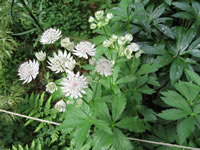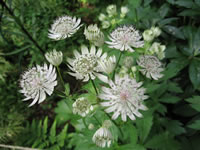|
Growing Requirements for Masterworts
When you are planning where to plant your Masterwort, consider where they they grow naturally... in damp, fertile, woodland conditions, or growing near the banks of a pond or small stream, where the soil always remains moist.
Ideally, Masterworts should be grown in a spot where they will receive a few hours of morning sun and dappled shade for the rest of the day. They will tolerate full sun if they have a constant source of moisture, but in most cases you would be better off to grow them in partial shade. Astrantia grown in full shade will have lush foliage but very few flowers.
Masterwort plants should be planted in organically rich, moisture retaining, slightly acidic soil
that has been enriched with a generous amount of well decayed compost at planting time.
If planted next to a pond or stream, make sure that the crown of the plant stands above the water table.
Water thoroughly and regularly. Masterworts will not survive periods of drought.
Feed in early spring and again at mid-summmer, using a good all-purpose, soluble fertilizer,
used according to the directions on the label.
Remove spent flowers promptly to encourage continued blooms.
Propagating Masterwort Plants and Growing Them from Seed
|
To help maintain your plant's vigor and to increase your collection,
Masterworts should be divided every third year, in early spring.
Masterwort seeds require a 2-3 month period of cold stratification
for germination to take place.
Seeds can be sown directly in the garden in early fall.
If you are starting your seeds indoors, place them in a zip-lock bag of moistened growing medium and keep them in the refrigerator for 3 months before planting.
After sowing, maintain a temperature of 70°-75° within the growing medium until germination, which takes about 4 weeks.
Older seeds tend to develop a harder shell as they age, and may need to be nicked (scarified) to facilitate a speedy germination.
Move plants to the garden after all danger of frost has passed in the spring.
|
|
Masterwort
Astrantia maxima
 |
 |
|

